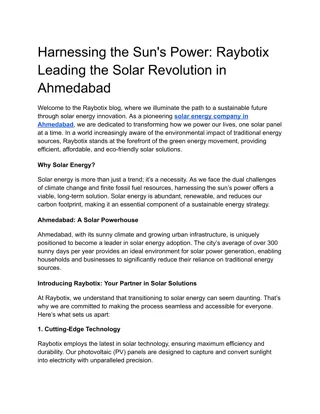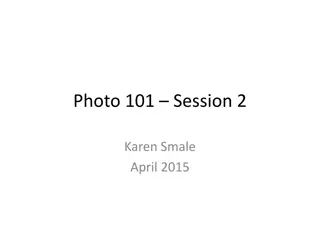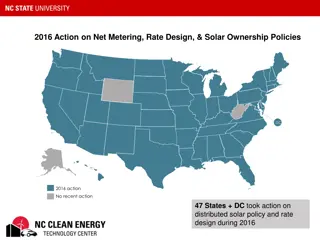Exploring Different Solar Metering Methods for Efficient Energy Management
Discover varying solar metering setups for residential and commercial properties, including dual and single meters with net metering, prepayment meters, and smart meters. Understand how these systems track energy usage, surplus solar production, and billing processes, optimizing electricity flow in grid-connected solar installations.
Download Presentation

Please find below an Image/Link to download the presentation.
The content on the website is provided AS IS for your information and personal use only. It may not be sold, licensed, or shared on other websites without obtaining consent from the author. Download presentation by click this link. If you encounter any issues during the download, it is possible that the publisher has removed the file from their server.
E N D
Presentation Transcript
Roof-top Solar Metering and Payment
Roof-top private solar for residences 1kW to 10 kW residential solar Off-sets house load About the same usage every day
Roof-top solar for commercial facilities and government buildings Commercial/Government building solar (typically around 10 kW up to 50kW or more) Commercial/Governmental loads often have a much lower load on weekends and therefore surplus solar
Metering of small grid-connected solar installations Dual meters Single meter providing net metering by reversing Single meter without reverse metering solar meter Prepayment meter Smart meter
Dual Meters Solar is connected directly to the grid through one meter Grid electricity is delivered to the building through the other meter Grid electricity minus solar electricity = the payment required from the customer to the utility or credit to be received by the customer for excess energy delivery This is the preferred approach for metering in the islands
Single meter that provides net-metering directly The solar is connected on the building side of the meter and surplus energy from the solar runs the meter backward. Negative reading indicates a credit, positive reading indicates a billing amount. Does not show either the customer or the utility the amount of solar energy or grid energy used by the building, only the net energy
Single meter without reversing Solar connected on building side of the meter Does not run backward when solar output exceeds building use Some meters may allow the excess solar to enter the grid (providing the utility free power) Most one-way meters will block energy flow from the building to the grid so utility does not receive the excess energy, it is lost to both utility and customer. Benefits neither the utility nor the customer
Solar meter A meter specifically designed for grid-connected solar. Has two readings, one for solar generation and one for total energy used by the house Expensive
Smart meter Utility can manage the metering of charges for grid power and credits for solar generation remotely. Most useful for utilities with high peak load generation costs and large diverse service area Typically shows only the net flow of power unless more expensive solar metering is specified. Solar generally not directly metered Can meter at different tariffs for different times of the day Expensive
Solar when pre-payment meters are used Solar is connected to the grid directly and a separate meter is used to measure solar delivery Credits for solar are provided the customer through the provision of top-up vouchers for the kWh shown on solar meter readings
Payment arrangements for solar inputs Feed-in tariff Solar offsets grid energy use only (no payment or credit for surplus solar generation) Net metering
Feed-in tariff Rate Paid for Solar kWh input Specific payment per kWh given for surplus power delivered to the grid Solar kWh that offsets grid kWh is effectively valued at the tariff rate since the customer saves that amount (and the utility loses that amount) Payment is strongly related to fuel offset cost but is best termed avoided cost of energy delivery Government may make the feed-in payment higher than the grid power tariff to encourage installing more solar May be lower than fuel offset cost or even zero if the utility does not want to encourage private solar for customers
Offset of grid energy use only Effectively zero feed-in payment for surplus energy. OK for the customer whose main energy use is during the day Commercial/government customers usually ok Residential customers usually not, most use of energy is at night
Net-metering Credit to pay for future energy use is provided when surplus energy is delivered to the grid Effectively feed-in tariff is the grid power tariff for the customer when full kWh credit is given for surplus Usually credits are cleared periodically so they do not accumulate beyond reasonable levels
Frequency of clearing surplus solar kWh credits Monthly For countries with reasonably constant solar over the year Annually For countries with seasonal solar (most of the PICs) clearing credits at the beginning of the high solar season makes sense A feed in tariff may be paid when resetting surplus solar credits























